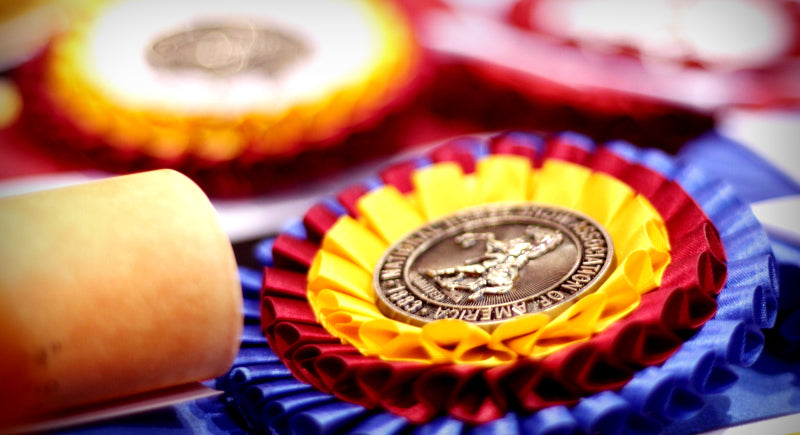The Three Keys to Winning Your Class Without the Most Expensive Horse October 31 2014 3 Comments

Ever had the ride of your life in a class full of World Grand Champion horses that have never or rarely lost a class? You get to the lineup, pat your horse for a job well done and say to your trainer as you exit the ring ribbon-less, “That was our best go yet!”
Well first of all, good for you for having a good attitude.
Sometimes being in a class of the best of equine talent the world has to offer means that no matter how well you do as a rider, you just won’t “make the cut.” It’s a reality everyone faces in every division of Saddleseat and every discipline of equestrianism.
Just like in any sport where you rely entirely on something else to be a part of your participation - be it a horse, a car, a bike, or even the proper shoes - money will factor in to your ability to excel when it comes down to it. Turning your essential piece of “equipment” into a commodity that can be bought means: having the best (i.e. having a horse with the best confirmation or physical ability) is going to cost you. While that’s a reality in all aspects of sport and even life, there are a few things you can do to combat that reality as a horseman/woman!
1. Showmanship
Get your horse out there. You will do yourself and your underdog horse little good if you are glued to the rail. With a ring full of equine talent like none other, why would the judge take a single look at your modest, yet beautiful horse? You have to make the judge look at you and make the judge realize, you and your horse are a team that has more than you can see at first glance. How can you accomplish that? Ride in groups whenever possible. Some school programs and barns don’t have the capacity to accommodate group classes, but if yours does, participate. Being in large groups for lessons will heighten your awareness of those around you, allowing you to cut the turn and get away from the pack like a pro!
2. Dot your I’s and cross your T’s!
High caliber classes are hugely exciting; not just for the rider, but for the horse as well. Think about it from their perspective. These are pack and prey animals. You are tossing them into an unfamiliar place with a bunch of horses they don’t know while the audience screams their hearts out for the beauty, elegance, and glory that is showing saddlebreds! You’re excited because you’ve worked all season for this and your horse is excited because they are like, “OMG WHAT IS THIS PLACE AND WHO ARE THESE HORSES!!!” Use it. Use it, but don’t abuse it! Sometimes a lack of good behavior is what can bring you and your underdog partner right up to the winner’s circle, so dot those I’s and cross those T’s, because the second those fancy expensive horses screw up, you will (hopefully) be showing the crap out of your horse AND behaving!
3. Practice
The most obvious (but most important) key to winning your class. If you aren’t hitting the ring at home with your horse, doing ground exercises to ensure optimum physical fitness, and doing as much practice with any other horse as possible, how in the world can you expect to have a feel for your horse and what they need to accomplish the two previous goals? Above all else, this is a sport. If you play basketball and you don’t practice more than a couple times a month when you get the chance, then show up to a huge game expecting to be started, you better believe if I was your coach you would be benched, because you would probably suck. Similarly, you can’t expect to be a capable and adaptable rider if you don’t ride and you definitely can’t expect to handle whatever is thrown your way if you are out of shape.
These are obviously only three suggestions on how to take your horse that you bought as a baby for next to nothing, then take it in the ring with horses you know sold for a quarter mil and kick butt. There’s far more to riding than showmanship, behavior, and practice, but it sure is a good place to start.


Comments
Linda Jo Wallen on February 02 2019 at 06:04PM
Growing up I had a lot of young and green horses to show for my dad and customers. I was left on my own to figure out a lot of techniques. You need to know your horse’s strong and weak capabilities, and this is accomplished through doing your homework at home. Sometimes we would ride in pairs or better yet in trios, putting the green horse in between 2 veterans. This really helped in training the inexperienced horse that he could still work nicely with other horses buzzing around him. I go into a few showing problems in my book, THE HORSE TRAINER’S DAUGHTER. The chapter on Cornfield Charlie, his nickname, is a good example.
OTTB owner on March 19 2016 at 09:03AM
$6000 is NOT NOT NOT an underdog!
in my eyes, that’s a ton of money to pay for a horse!
Mine was a starved OTTB – now that’s an underdog.
Rebecca on October 26 2015 at 09:25PM
You are so true, my little $6000 horse I bought without seeing at an out of state auction and 2 yrs later we won the 3-gaited under 2. The next yr we got 3rd in the championship at Jr. League. I love this little guy, he has let me live way above my life dream, I never thought I’d have a horse that I could show at Louisville! Good luck to everybody it can happen!!!!!!! :)
Rebecca & All Rise (Buggar)